|
|
|
|
would like to deal at the beginning immediately with the
contemporary circulation of the tiger. The center of the contemporary
tigerpopulation lies in India, how one can already think.
About 3.750 tigers in more than 300 reservations still existing
there. The Indian government is the only one which already
hung up a program to the protection of the tigers in the 70ern
of the last century (politics
& protection). The second bigger population is not
to be found how one would be able to accept carelessly in
Sibiria. The sumatratiger on the Sundaisland sumatra sets
up the second-largest number with approximately 500 tigers
on tigers of an sub-kind. No 300 animals more exist probably
today from the Amurtiger in freedom. I more see no chances
for the China tiger (amoytiger).
From that sub-kind it appears like than there are less than
100 animals - this is too little for receipt of this sub-kind.
| On
the right edge you can see a representation of the contemporary
circulation area at the contained graphic. India, China,
some parts of Russia and a big part of Indonesia can
you see here. The green faces show the tigerpopulations.
The population of the sibirian tiger is so far scattered
and thin that it is not possible to represent this clearly
in the chosen measure. |
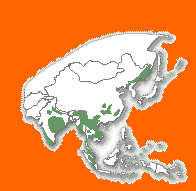 |
|
|
|
|
Consequently, one finds tiger on the Indian sub continent,
in the east Russian Sibiria, today on sumatra and in parts
of China. All other circulation areas which the tiger settled
can be designated today heavy heart as tiger free. You can
find out the various reasons for this coming about below politics
& protection (via the above link).
|
|
|
I would like to however now come at the
more brilliant times of the tiger. It makes little sense on
my perspective if I hundred from place names without a chart
designate. On this basis, the text is disturbed again and
again by maps. Many of the maps can also become found in the
map
house - I recommend you a look there.
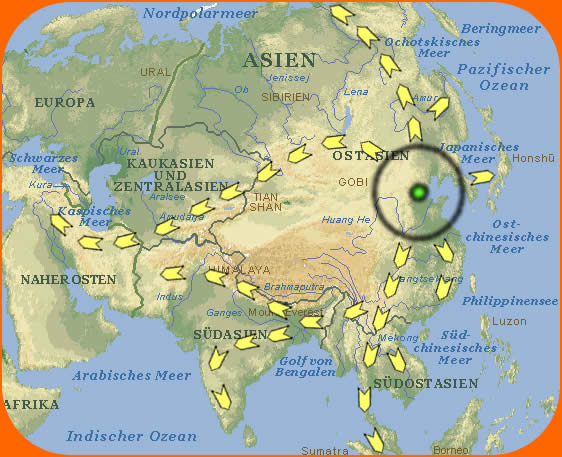
This is a schematic representation of the tiger
spreading in the past. The black ring is the area in which
the first developed modern tiger for itself where the green
point is the hypothetical origin center in the middle. The
yellow arrows represents the directions of propagations and
hiking ways dar. The Indian tiger has the least adaptations
on its way durch revived and consequently, is the most initial
form --> and therefore predestined as nominatform. The
circulation area was gigantic. Subsequent representation shows
circulation over that Sundaislands.
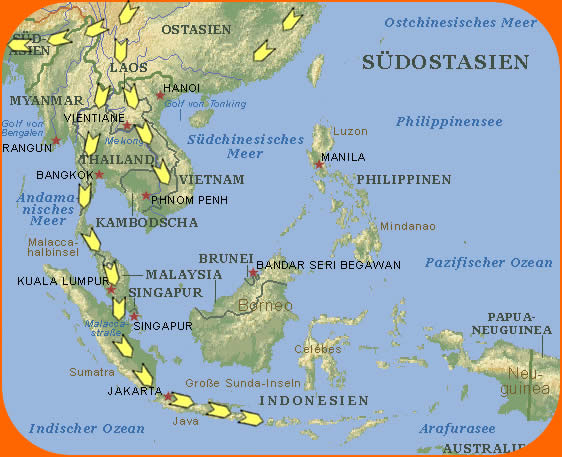
These representation shows the process of spreading
of the tiger on the contemporary Sundaislands. The tiger came
via Cambodia to contemporary Malaysia. He came from there
from after sumatra - over a possible land bridge or also swam
through the strait. Sumatra served as a springboard after
java and bali. Therefore, the question might set itself today
still up, whether java- and sub-kinds own balitiger really
were or also that what we designate as sumatratiger today.
In as long the position of the sumatratigers as a own kind
Panthera
sumatrae here a role plays however, is questionable.
|
|
|
As we can recognize, the main country of
the tiger is the northeast China. From here from, the tiger
entered upon its victory train to the north, upon west and
upon south. He achieves the northern fields from contemporary
point of view relatively simply since the climatic conditions
were by far better than today. The climate of the early one
Pleistocene in northeast Asia was moderate. When however the
climate became relatively harder and colder in the later Pleistocene
through the Ice Age, the tigers more and more were pushed
to the south. However, some tigers adapted to these intensified
conditions and in such a way, could consider degree Centigrade
at temperatures to -40° in the winter - the ancestors
the contemporary amur- and/or ussuritiger.
Spreading to central Asia was considerably more difficult.
Example manner reached the first tigers that caspi mountains
only according to that off fade away the Ice Age. The information
about tigers in the west of Asia is extremely rare yet reports
on tigers exist which advanced up to the baikal lake and/or
were also domestic in the contemporary Afghanistan and Pakistan.
However, these were relatively soon exterminated. The tiger
occurred regularly in all its former circulation areas - however,
the contemporary situation results for other reasons. Too
former times the jablonowy mountains in transbaikalia was
a natural boundary to the west. Behind this border was no
regular occurrence.
The strongest tigerpopulations extended since ever on large
rivers along. In east Sibiria, the two rivers Amur and Ussuri
limit the main tiger field. It however, also occurred cases
in which tiger from this core business up to Sachalin advanced.
Sachalin is a the sibirian mainland preceding island in the
pacific ocean that is the Delta of the amur rivers opposite
(recognizable on the upper card).
The tiger area even extended up to Heiljongjang and the banks
of the Chanka lake in this field. Even the northernmost Mongolia
occasionally became passed by tigers. of individual tigers
I would like to still address the tigers of Korea in order
to remain in this corner of the world ich. In northern Korea,
there was almost tiger exclusively in the field of the Puksubeksam
mountains near the city Unesan. There was hardly tiger in
other parts of Korea - this circumstance even causes discussions
today since the reasons seem to be fuzzy for this field limitation.
Itself I could hardly find information on this subject. Further
tiger occurrences in the east of China are only handed down
from the coast areas - furthermore, these should also play
further role process no one.
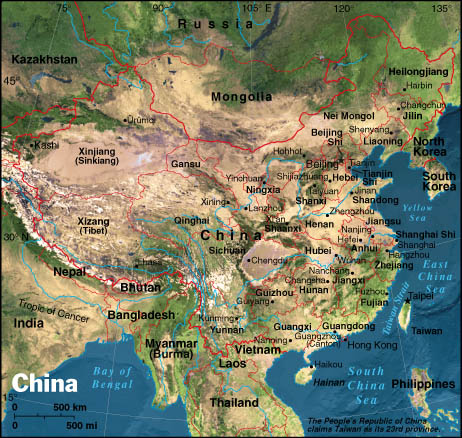
The southeast part of the tiger field must also be taken
more precisely natural under the magnifier. In addition to
rear India, numerous reports also come from Burma and/or Myanmar.
A great number of tigers were main from the upper Chindwin
area known. However, is of course engaged it that the tiger
existed in the entire country Burma. He came even on the peninsula
Malaka down to Singapore. Tigers existed too in Thailand.
They follow big courses mainly there. From other parts of
Thailand, tiger occurrences are not hardly to at all confessed.
Even further the Sundaislands are to the south of course still
available. Good and dependable reports may come might carry
out from Sumatra. The tiger occurred there too in the farawa
spur of the island. Only at newer time, the tiger is threatened
there extremely strongly. On the lower spreading board, Sumatra,
Java and Bali (to the right of Java) can be seen.
|
|
We might now approach the slopes of the
Himalaya and the Indian sub continent. Tigers occur mainly
at the southern slopes of the Himalayas. By the tiger countries
Nepal, Buthan and Bengalis is to be mentioned here in the
first place. A strong circualtion center extends to there
from Bengalis, via the entire front India to cape Cormorin.
It might be said not know the ch's Cormorin for aller that
this cape is the southernmost top of India. Kanyakumari
is the largest city at ch that at the state Tamil Nadu (India)
is and a religious center of Hinduism is.
However, there is an exception in India. At this place,
tigers never occurred after the contemporary knowledge state.
The speech is by the koromandel coast - this is that southeast
coast of front India. Tigers never also occurred on Ceylon
(Sri Lanka). With the reasons for this I would like to however
deal only at the end of my carrying out. The western boundary
of the Indian tigerpopulation is also today the aravalli
mountains and the spurs of the desert Tharr. The Tharr desert
is about 800 kms long and 460m km broad. She for the most
part lies at the Indian state Rajasthan and a very "warm"
desert steppe is with maximum temperatures of 50° degrees
Centigrade.
In the western part of northern India, the state Kumaon
is above all famously notorious as a human being eater country.
People
eating tigers in fact seem to occur mainly here - the
reasons still lie to a large extent in darkness. A similar
bundled occurrence on man-eaters is also known from the
eastern part of northern India, the Sundarbans - a coast
landscape in Bengalis, contained the south of the Delta
field of walk and Brahmaputra. The most dangerous tigers
of the world should exist there. You find increase for this
under man-eaters.
From other tiger fields or from other tiger lower kinds
than the Indian tiger at all, incidents and human being
gobbling are not confessed (me!). The tiger is no more to
be found in all of India today (see most supreme card).
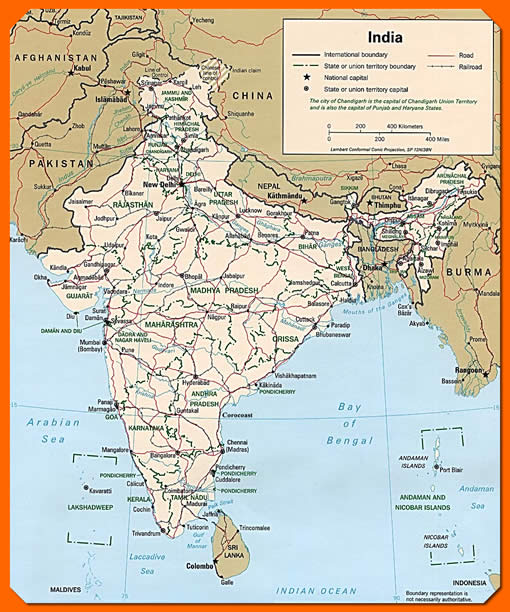
For an enlarged representation, you can accrete
onto the map. In such a way, it is possible to consider
a detail richly card.
|
|
|
The occurrence the tiger in the all of Pakistan
is a bone of contention in science. It expressly must be stressed
that one could only prove tiger with safety in the eastern
areas of Pakistan and of Afghanistan. However, some researchers
still go out from that that both countries "were"develop""
completely by tiger. In the late 70er years of the 20sten
century, there were also reports on tigers in southeast Turkey
close to the city Uludere. This area is about 45 kms away
from the turkish-iranian boundary and is at the cymbal of
the river Tigris - too in the mountains of the northern Iraq.
Here was a Ca. one-year old tiger pup bags. In this however,
pups are not yet old man themselves continuous and in such
a way, it must become gone out by it that the tiger mother
coursed near. It would be extremely non-typical if a tigress
with its boys in this age would leave the birth area. Consequently
was borne small tigers in this area (probable). The tigers
in this area exist therefore, could consequently, become pulled
as a upshot. To what extent, these conclusions are valid today
ones or whether they retrospective considers correctly be
were is not followable.
In the complete circulation area, the tigers are not only
to be found on specific altitudes. Regardless whether flat
or ascending mountains to 3.500 m, the tiger occurred regularly
there depending on population density - today unfortunately
no more. Many researchers and V. G. Geptner, A. A. Sludskij
or also R. I. Pocock in these circumstances investigated more
precisely yet is hardly it here possible everything to mention
these details. The question gives many controversies, around
theory of tiger circulation, as for example whether there
was tiger on Borneo. The tooth of a young tiger was found
like this in Borneo. However, can not be derived it from a
tooth that tigers existed there.
As a end, I would like to be still occupied with boundaries
and obstacle in the tiger field. Why gives it one of these
questions was no tigers in Sri Lanka! This can one actual
only with late arrival the tiger explain in India. If one
accepts the tiger as a northern animal (usual opinion), he
had "migrate" only to India on the shown ways. The
tiger arrived when Sri Lanka already had no combination of
the mainland as only to the southern India. Since however
are elephants and leopard there on Sri Lanka, these developed
the southern living space in former times. That it is the
tiger only of approx. 6.000 years came to India to be assumed
in fact. During animals and elephant and leopard and lion
already designated in early cultures may be, only appears
the tiger for instance 1.100 years B. C. in mythology.
A further remarkable circumstance is the not regular occurring
of tigers in more western fields as responded already. The
tigers to Pakistan and that in India of the spreading line
have to in such a way do nothing with each other. Why are
the Indian tigers wandered all the way to Afghanistan not
or the tigers there to Indiadouble-question This question
is simple: There is a gigantic rampart between these two countries,
that Hindu knuckle. This is a further fact, that the origin
of the tiger of north. It can be excluded that he is an animal
resulted to the south.
I must still mention the "Assam corridor" end final.
Prevent things and deserts and mountain ranges of course,
that animals advance certainly into other earth areas, however
possibly nevertheless gives it a gap in this closure belt
this are then mentioned corridors. The tiger reached through
the Assam corridor from north to the southern India. Systems
and the high mountains from Cashmere and at the one or the
west Indian deserts on the other hand, the Assam corridor
prevent other arcades to India. Many other animals followed
the tiger or preceded him, others remained in the mountains,
since this living space also agreed them - yet the tiger natural
not, although there are also some few tigers in the high mountains
areas of the Himalaya.
|
|
For information
about the biohistology of the tiger please, go at the biohistological
page. Should you have still questions for the circulation theory
of the tiger, then write me an email: |
|
|
|
|